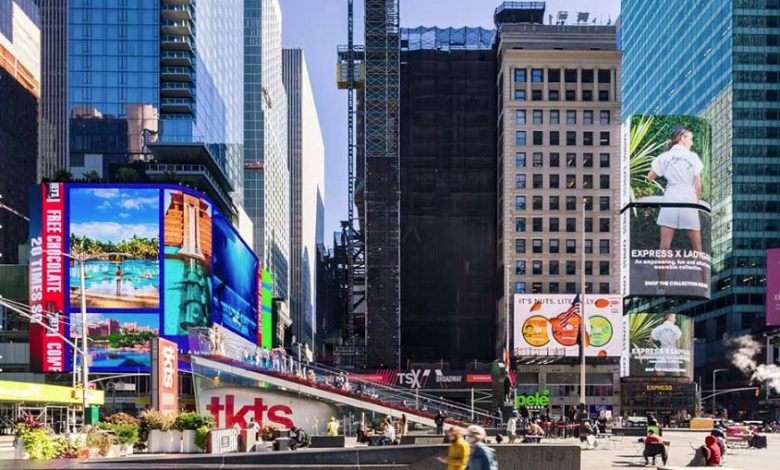How a 7,000-ton Broadway theater was hoisted 30 feet

The TSX building, center, which includes a 661-room hotel and an outdoor stage, in Manhattan’s Time Square, Oct. 15, 2020. In order to add retail space underneath, the developer of the hotel and entertainment complex has managed to lift the 14 million pound Beaux-Arts style Palace Theater, a protected landmark, three stories without sending anything crashing down to earth. Jeenah Moon/The New York Times.
by C.J. Hughes
NEW YORK, NY.- If you’ve ever lost at Jenga by toppling a tower after removing a block, you might appreciate what developers have accomplished at TSX Broadway, a hotel and entertainment complex in Times Square.
The developer of the 46-story building has managed to loosen its bottom floors and lift them 30 feet without sending anything crashing down to earth.
And what has been elevated is not just any old section, either. It’s the Palace Theater, a home for Broadway shows that was designed by architectural firm Kirchhoff & Rose in the Beaux-Arts style. The theater, which weighs 14 million pounds, is a protected landmark, meaning the structure, from the stage to the balcony, had to be moved without suffering as much as a crack in the delicate plasterwork adorning ceilings, arches, and box seats.
“It’s been quite a feeling to see it happen,” said Anthony Mazzo, president of Urban Foundation/Engineering, which accomplished the heavy lift using a system of jacks and telescoping beams that he invented 30 years ago for a project involving a warehouse roof in Queens. “I feel like it’s worked like a charm.”
Even in a city known for outsize construction feats, the project was full of risks, from possible damage to the ornate interior to the chance that the entire theater would crash to the ground. But it was a crucial part of a $2.5 billion transformation of the building, which will include a 661-room hotel and an outdoor stage facing Times Square when it opens next year.
Since 1913, the 1,700-seat Palace occupied the bulk of the ground floor at West 47th Street and Broadway, drawing hundreds of visitors eight times a week to see musicals such as “Annie,” “Sunset Boulevard” and “West Side Story.” But offering only live theater was choking off an even bigger source of revenue: the tens of millions of tourists who swarm Times Square in a typical year, eager to spend money in stores.
To tap some of that potential revenue, L&L Holding, the lead developer on the TSX project, made arrangements with the theater’s owner, the Nederlander Organization, to elevate the Palace and fill the void with three floors of new shopping space, part of 10 floors of retail in the tower. The theater will have a new entrance on West 47th as well as a new lobby, marquee, and backstage area.
“It was critical for us to lift the theater to create the space, but also to unlock the potential of the theater, with all the things that would help it become a modern building,” said David Orowitz, an L&L managing director.
Anybody who has ever changed a car tire by using a strategically placed jack or frame rack might be familiar with how the Palace made its upward journey.
A crew of three dozen workers first strengthened the theater by adding a 6-foot-thick concrete layer around the edge of the base, then sank 34 columns 30 feet into the Manhattan bedrock beneath it. Fitting snugly into the columns, like hands in gloves, were smaller beams that could move up and down like telescope parts. Four hydraulic jacks resembling large paint cans with arms that extended up were placed under collars on each beam.
When the jacks were turned on, they pushed the collars up, and the theater with them. After the jacks’ arms were raised a mere 5 inches, workers stopped the lift, secured the theater at its new height, adjusted the collars and fastened them with large bolts, repositioned the jacks, and restarted the whole process.
In March, when the Palace had cleared 16 feet, the lift project was paused so workers could construct new floors in the freshly made space, which also helped to support the theater.
Throughout the process, a few people huddled in a plywood shack watching monitors in the theater. A slight tilt less than a half-degree would have been enough for a hard stop, said Robert Israel, an executive vice president of L&L who worked on the TSX project.
Further complicating the delicate nature of lifting a 7,000-ton theater, many aspects of the TSX project have overlapped since work began in 2019, including the demolition of the old Doubletree Hotel above the theater and the construction of its replacement, the pouring of a new foundation and the addition of 51,000 square feet of signage on the building’s exterior.
Also, zoning codes have changed since the tower was added in the late 1980s, which could have meant a significant reduction in square footage for the final product. But under current New York zoning law, if a renovation project keeps one-quarter of its floor space in place, it can preserve its original square footage.
To ensure that TSX Broadway maintained its size — about 500,000 square feet — L&L had to retain many of the existing concrete slabs from the 16th story on down, essentially keeping them suspended in the air while construction proceeded around them in another Jenga-like feat.
“This is by far the most complex project that I have ever undertaken, that L&L has undertaken,” Israel said as he stood in a dim, cool space beneath the Palace, which bore construction notes scrawled in spray paint that theatergoers will never see.
The theater reached its final height on April 5.
Now, as the theater prepares to welcome visitors once more, it is seen as a proxy for the rebound of Times Square and New York.
This article originally appeared in The New York Times.



